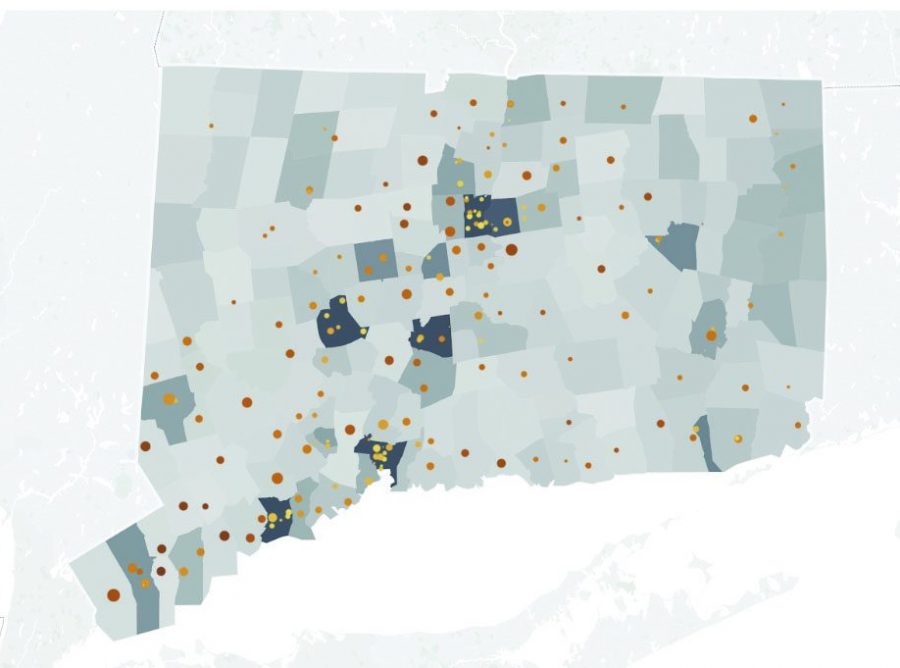Standardized Testing is Inherently Unequal
The background is segmented by town area, and the shades of grey showcases the percentage of people under SNAP- Supplemental Nutrition Assistance Program. A darker shade signifies that more people in that town receive SNAP. The bubbles are data from all public high schools in Connecticut, showcasing the percentage of students in that school that scored over a set national benchmark on the SAT. A higher percentage, which corresponds to generally better academic performance, are darker shades of orange. Very evidently, the schools with poorer performing students bodies coincide almost perfectly with with towns where a higher population receive food assistance. This is regardless of geographic location too, schools from different districts that are near each other still follow this trend.
The original intent of the SAT was to provide an accurate indicator of a student’s readiness for college and “scholastic aptitude.” Nowadays, it has deviated from its original objectives.
The SAT has morphed into a fallacious indicator for college admissions. In the process, it has become a living nightmare for students applying to U.S. colleges from around the world. It is an indicator not of how well one will perform in college, but of how good one is at cramming vocabulary definitions or whether one is to be able to afford a tutor. It’s an antiquated test in our increasingly competitive and cutthroat academic environment, and it needs to be abolished.
By far, the largest problem caused by these standardized tests is the unstandard ways it treats its test takers. In environments such as Hotchkiss or other private schools, where a student is expected to perform well, a score above 1500, which already constitutes the 99th percentile of all 1.7 million test takers, is no longer just desirable, it’s expected. For average applicants from these institutions, not only do these imposing expectations detract from a legitimate education by forcing the student to memorize trivial content for a single test, the test itself provides little to no diagnostic feedback regarding how the student is actually performing or will perform in college academic life. In fact, a study conducted by the College Board on the effectiveness of their SAT test found that high school GPA is an even better predictor of college performance than the SAT.
On the other hand, this culture of standardized testing is even more injurious to students of lower socio-economic background, where it serves as a major roadblock to pursuing higher education. Not only do these students, who have access to fewer resources and economic support, have to compete with standards set by well-off students, but the test is constructed in a way that it is inherently biased against them.
A survey of public high schools in Connecticut comparing school-wide SAT results with economic indicators corroborates this accusation of bias: the percentage of students who perform under a certain benchmark directly correlates with the percentage of Supplemental Nutrition Assistance Program (SNAP) recipients in that town. In essence, the more people who receive food welfare in a given town, the less well the students there perform.
Trends like these aren’t just a state-wide phenomenon. It’s happening all around the country, where economically disadvantaged students are consistently performing poorly on standardized tests. In Massachusetts, where more data is available, there is an almost direct correlation between the proportion of economically disadvantaged students in a given school and the average SAT scores at that school. Additionally, the College Board data shows that students who identify as African American, Hispanic, or Native American consistently scored an average of 150 points lower on the SAT than students who identify as White or Asian, in every state. In Connecticut, for example, Asian students scored an average of 1192 points, while African American students only scored an average of 908 points – 284 points lower.
The existence of such economic or racial bias in a standardized test opposes purpose of a standardized test – which is to provide all students with an accurate baseline measurement of academic skills. Our status quo serves as a grave indication of what’s to come for the next generation of students if the College Board (or similar organizations) are allowed to continue administering these bigoted assessments. Deep down, standardized tests like the SAT undermine the fundamental commitment of our educational system dating back to Brown v. Board – to provide equal opportunity to all students. It’s a nearly century-old conception of standardization within our non-standard educational realm, and this is why the SAT, along with other standardized assessments, has to go.






